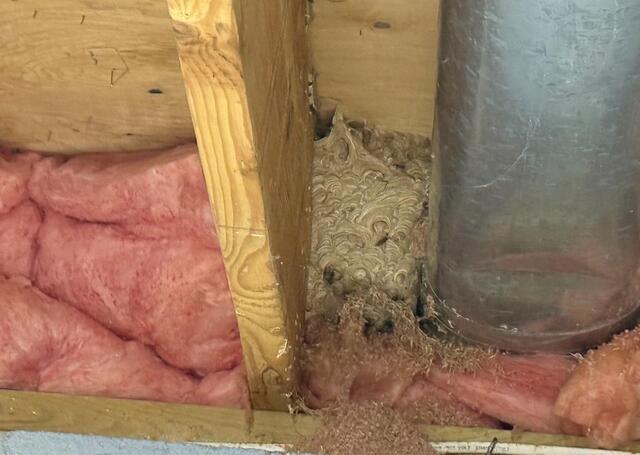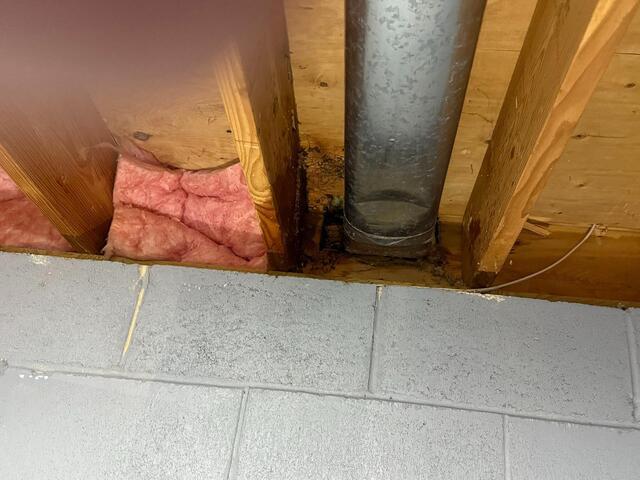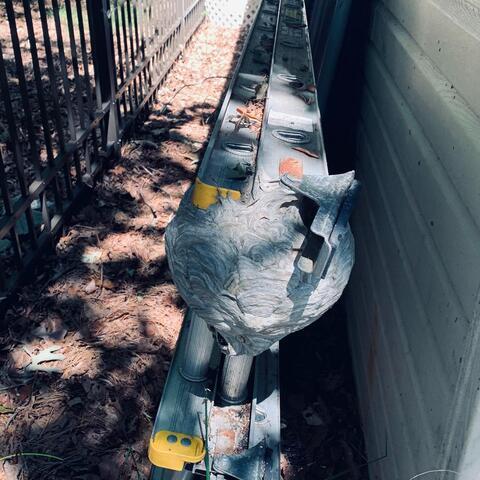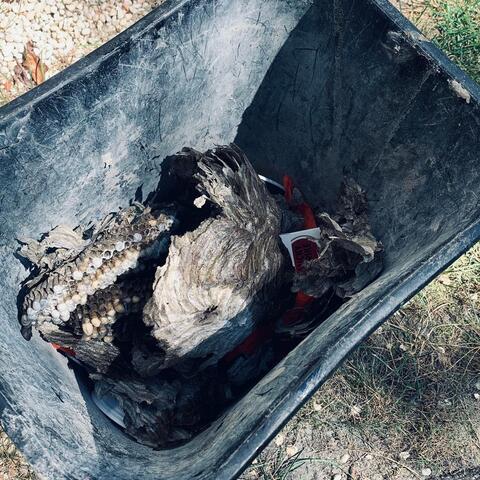Cowleys Pest Services Before & After Photos
Click on a photo to enlarge.
No More Groundhogs Burrowing Underneath the Deck in Princeton Junction, NJ
There were plenty of open areas around this customer's shed in Princeton Junction, NJ that the groundhogs used to harbor underneath the area! The entire shed was elevated and completely open! After we had safely retrieved all of the groundhogs and took them to a new humane location, we began excluding the shed.
First, we installed a new wooden trim for the upper sections of the shed. After that, we installed a new and sturdy lattice around the entire perimeter of the shed to properly close off all the open areas. Lastly, we installed Dig Defense® around every single new piece of lattice we installed. Dig Defense® is a below-ground fence system that is 15 inches deep, 4 feet across, and protects structures against all wildlife!
Yellow Jackets Hiding in the Insulation in West Windsor, NJ
As this homeowner in West Windsor, NJ was removing a few items out of his basement, he was attacked by several yellow jackets! He quickly ran upstairs and called Cowleys. After equipping our protective bee suit, we began inspecting the basement. A few minutes into our investigation, we discovered the yellow jackets nest. It was hidden behind a piece of insulation!
For treatment, we injected a knockdown dusting product, waited several moments, and then injected a knockdown aerosol application directly into the nest. These treatments will neutralize the yellow jackets quickly. A short while after applying the products, we removed the nest, and the piece of insulation that was stuck to it, and disposed of them properly.
Bald-Faced Hornets Use the Ladder in West Windsor, NJ
Recently, we were sent out to a home in West Windsor, NJ to treat for hornets. We were informed that the nest was located on the bottom of the customers ladder, so that's where we inspected. As we took a closer look at them, we identified them as bald-faced hornets. Bald-faced hornets are social stinging insects that have white markings on their face. They're EXTREMELY aggressive and territorial. So aggressive that if anyone or anything comes within close proximity of their nest, they will attack! What makes them even scarier is they can actually sense vibrations in the air (when you mow your lawn) and remember their invader's face!
First, we injected a knockdown dusting application into the nest, waited a few moments, and then injected a knockdown aerosol application. Both of these applications quickly exterminate the bald-faced hornets. Several moments after applying these products, we removed the nest and disposed of it properly.
Humid & Messy Crawl Space Gets Transformed in Basking Ridge, NJ
Our Crawl Space team was sent out to the home of a new customer in Basking Ridge, NJ, to help them out with their humid and messy crawl space. Due to the high humidity levels in the crawl space, the insulation was saturated and falling down. Fortunately, there wasn't any mold growing in the crawl space.
First, we removed all of the contaminated insulation, as well as other debris, out of the crawl space and properly disposed of them. Next, we removed the old vapor barrier and added a drainage matting. This is a dimpled plastic mat that allows all excess moisture to work its way over to sump pump. Afterward, we added a reinforced polyethylene plastic film on top of the drainage matting. The next thing we did was seal off all the exposed vents throughout the crawl space. This will prevent any outside moisture, as well as any rodents or pests, from entering the crawl space.
Next, we installed ComfortTherm® Insulation throughout the crawl space. ComfortTherm® Insulation is poly-encapsulated and is ideal for moisture-rich crawl space environments. The insulation also helps to preserve the air quality and reduce energy costs. ComfortTherm® insulation also provides excellent temperature and noise control, and comes with a vapor-retarder for use in hot, humid climates. Lastly, to control the humidity levels in the crawl space, we installed a Sedona dehumidifier. This is a powerful, energy-efficient, commercial-grade dehumidifier that outperforms standard household dehumidifiers by as much as 10 times while using the same amount of energy to run.
Starlings Nest in Concrete Ceiling of Party Deck in Piscataway, NJ
Starlings had infested this football stadium in Piscataway, NJ and were roosting in the concrete ceiling of one of the party decks. Since both management, staff, and football fans weren't too keen of getting bird droppings on them, Bird Solutions by Cowleys was sent out.
First, we carefully removed all of the nesting debris and then disinfected the areas with a solution that exterminates bird mites. Afterward, we removed the old material and installed bird netting. In order make sure the bird netting is secured, we used a stainless steel cable with net spikes and anchored it into the walls. We then locked the cables in place using copper ferrules and then installed turnbuckles which tighten the cable.
Bird netting is a 3/4 inch, heavy duty polyethylene bird netting that's used to humanely block the starlings from entering any unwanted areas. It creates an impenetrable barrier that denies the starlings, as well as all nuisance birds, access to these areas and removes the landing areas for them. The starlings are going to fly around, realize they can't enter, and move on. Now the stadium is properly excluded from all nuisance birds.









